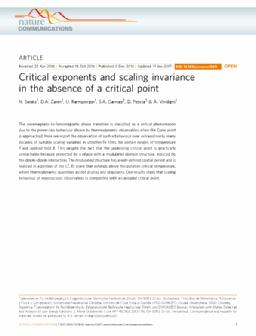| dc.contributor.author | Saratz, Niculin | |
| dc.contributor.author | Zanin, Danilo Andrea | |
| dc.contributor.author | Ramsperger, Urs | |
| dc.contributor.author | Cannas, Sergio Alejandro | |
| dc.contributor.author | Pescia, Danilo | |
| dc.contributor.author | Vindigni, Alessandro | |
| dc.date.accessioned | 2023-08-23T15:25:46Z | |
| dc.date.available | 2023-08-23T15:25:46Z | |
| dc.date.issued | 2016 | |
| dc.identifier.uri | http://hdl.handle.net/11086/548563 | |
| dc.description.abstract | The paramagnetic-to-ferromagnetic phase transition is classified as a critical phenomenon due to the power-law behaviour shown by thermodynamic observables when the Curie point is approached. Here we report the observation of such a behaviour over extraordinarily many decades of suitable scaling variables in ultrathin Fe films, for certain ranges of temperature T and applied field B. This despite the fact that the underlying critical point is practically unreachable because protected by a phase with a modulated domain structure, induced by the dipole–dipole interaction. The modulated structure has a well-defined spatial period and is realized in a portion of the (T, B) plane that extends above the putative critical temperature,
where thermodynamic quantities do not display any singularity. Our results imply that scaling
behaviour of macroscopic observables is compatible with an avoided critical point. | en |
| dc.format.medium | Electrónico y/o Digital | |
| dc.language.iso | eng | es |
| dc.rights | Attribution 4.0 International | * |
| dc.rights.uri | http://creativecommons.org/licenses/by/4.0/ | * |
| dc.source | e-ISSN 2041-1723 | |
| dc.subject | Scaling | en |
| dc.subject | Critical | en |
| dc.subject | Dipolar interactions | en |
| dc.subject | Ultrathin magnetic films | en |
| dc.title | Critical exponents and scaling invariance in the absence of a critical point | en |
| dc.type | article | es |
| dc.description.version | info:eu-repo/semantics/publishedVersion | es |
| dc.description.fil | Fil: Saratz, Niculin. Eidgenössische Technische Hochschule Zürich. Laboratorium für Festkörperphysik; Switzerland. | es |
| dc.description.fil | Fil: Zanin, Danilo Andrea. Eidgenössische Technische Hochschule Zürich. Laboratorium für Festkörperphysik; Switzerland. | es |
| dc.description.fil | Fil: Ramsperger, Urs. Eidgenössische Technische Hochschule Zürich. Laboratorium für Festkörperphysik; Switzerland. | es |
| dc.description.fil | Fil: Cannas, Sergio Alejandro. Universidad Nacional de Córdoba. Facultad de Matemática, Astronomía, Física y Computación; Argentina. | es |
| dc.description.fil | Fil: Cannas, Sergio Alejandro. Universidad Nacional de Córdoba. Instituto de Física Enrique Gaviola; Argentina. | es |
| dc.description.fil | Fil: Cannas, Sergio Alejandro. Consejo Nacional de Investigaciones Científicas y Técnicas. Instituto de Física Enrique Gaviola; Argentina. | es |
| dc.description.fil | Fil: Pescia, Danilo. Eidgenössische Technische Hochschule Zürich. Laboratorium für Festkörperphysik; Switzerland. | es |
| dc.description.fil | Fil: Vindigni, Alessandro. Eidgenössische Technische Hochschule Zürich. Laboratorium für Festkörperphysik; Switzerland. | es |
| dc.journal.country | Reino Unido | es |
| dc.journal.editorial | Nature Publishing Group | en |
| dc.journal.referato | Con referato | |
| dc.journal.title | Nature Communications | en |
| dc.journal.volume | 7 | es |
| dc.description.field | Física de los Materiales Condensados | |
| dc.identifier.doi | https://doi.org/10.1038/ncomms13611 | |
| dc.contributor.orcid | https://orcid.org/0000-0002-7749-4104 | es |
| dc.contributor.orcid | https://orcid.org/0000-0003-4424-2418 | es |
| dc.contributor.orcid | https://orcid.org/0000-0001-7331-3532 | es |
| dc.contributor.orcid | https://orcid.org/0000-0001-7436-418X | es |
| dc.contributor.orcid | https://orcid.org/0000-0003-1941-5989 | es |





